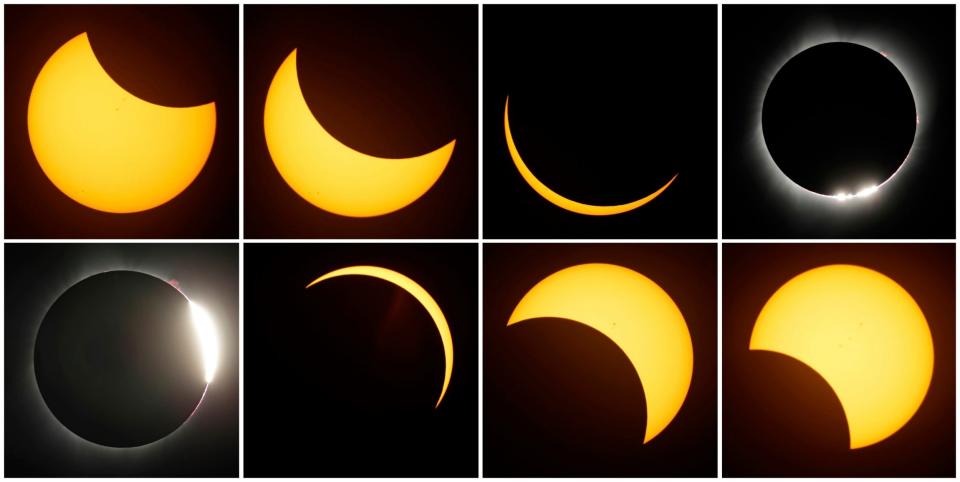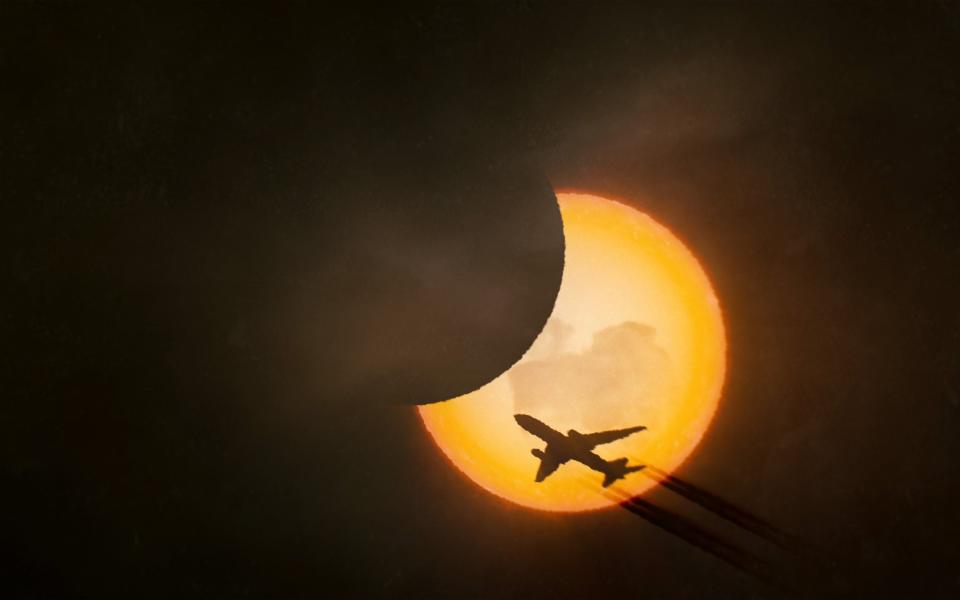Millions of people will see a total solar eclipse on Monday, April 8, 2024, with the path of totality spanning much of Central and North America for the first time in more than 100 years.
But the eclipse, albeit a partial one, will also be visible in parts of the UK and Ireland on Monday.
Here’s everything you need to know about the rare astronomical phenomenon known as the Great American Eclipse, including where you can see it, how to see it in the UK, and what time it starts.
What is a solar eclipse?
During a solar eclipse, the moon moves between the Earth and the sun, blocking the sun’s rays from reaching the Earth. During a partial solar eclipse the moon covers only part of the sun, but during a total solar eclipse the sun is completely blocked by the moon – cloaking the earth in darkness and creating a ring of light (corona) in the sky. Weather permitting, a significant swath of Central and North America will witness a total solar eclipse on April 8.
Solar eclipses are not as rare as you might think. Usually two to four occur per year, but total solar eclipses are rare.


When will the 2024 eclipse be, and how long will it last?
The solar eclipse will take place on Monday and will last two hours in total, although the spectacle will only last between a minute and four and a half minutes in any particular place on the path of totality, depending on where you are. It will first appear in Mazatlán, on Mexico’s Pacific coast, at 11.07am local time (7.07pm UK time), and the total will hit US territory in San Antonio, Texas, at 1.33pm local time ( 7.33pm UK time). The event will finish in Newfoundland at 5.12pm local time (8.42pm UK time). Radar Base, Texas, near the Mexican border, will be the place in the United States that will receive the longest eclipse – here the total will last four minutes and 27 seconds.
Where are the best places to see the total solar eclipse?
The April 8 total solar eclipse will begin over the Pacific Ocean before passing over Mexico, the United States and Canada – the path of totality will be 115 miles wide, meaning several million people could see the spectacle. US states that will experience the total solar eclipse will include Texas, Oklahoma, Arkansas, Missouri, Illinois, Kentucky, Indiana, Ohio, Pennsylvania, New York, Vermont, New Hampshire and Maine, with small parts of Tennessee and Michigan also experienced the. eclipse. The total solar eclipse will also be visible in Canada in Southern Ontario, Quebec, New Brunswick, Prince Edward Island and Cape Breton.
Among the main cities in North America that fall in the path of totality are Dallas, Indianapolis, Cleveland and Buffalo, as well as Hamilton and Montreal in Canada. Areas close to the path of totality will still be able to see a partial eclipse, with part of the sun covered by the moon’s shadow.
Will the solar eclipse be visible from the UK?
The total solar eclipse will not be visible in the UK, although parts of the west of the UK and Ireland may see a partial eclipse just before sunset on Monday. Parts of the UK that may have a sighting include Cardiff, Edinburgh, Glasgow, Manchester, Liverpool and Leeds. This partial eclipse will last between 7.52pm and 8.51pm.
In Balearic, Ireland, 44 percent of the sun will be obscured, while Dublin will have a partial eclipse of 15 percent. On the soil of the United Kingdom, Belfast will see an eclipse of 17.3 percent, Glasgow will experience 11.2 percent, and Liverpool will experience only 0.64 percent of the partial solar eclipse. To watch it, you will need to have a clear view to the west, and wear the appropriate UV glasses to avoid damage to your eyes.
When was the last total eclipse in the UK?
The last total solar eclipse in the UK was in 1999; however, many parts of Western Europe were affected by poor visibility due to cloud cover. People who gathered to see the eclipse from Lizard and Perranporth in Cornwall experienced totality, as the clouds broke for a moment.
When is the next total solar eclipse in the UK?
The next total solar eclipse in the UK will be on September 23, 2090. Totality will be visible in Newquay, Plymouth, Southampton, the Isle of Wight, as well as parts of northern France (including Paris) and southern Belgium. The next total solar eclipse in the United States will be in 2033, except over Alaska, and then in 2044.


Can I watch the solar eclipse online?
NASA will live stream the event, which will feature conversations with experts and up-close views of the cosmic phenomenon. The stream will start at 6pm UK time and will end three hours later. You can see this on the NASA website. There will also be live coverage of the event on the BBC website.
What is the weather forecast for the solar eclipse?
Since the event will span hundreds of miles, from Mexico to Canada, the weather forecast will vary widely across the path of totality. The Washington Post it has a nice tool that shows the cloud cover forecast across the path of totality. Based on historical weather patterns, the southern states of the US and Mexico are likely to experience less cloud cover. In the UK, the weather forecast is currently cloudy with rain across western areas where the partial eclipse may be visible.
What really happens during an eclipse?
During a total solar eclipse, if the weather is clear, everything will be dark for a few minutes. The temperature will drop, street lights may come on, and birds often behave unusually. Sun rays will appear as crescents – if you hold a colander out, small crescent shadows will appear on the ground. Several stars will be visible, as well as planets including Venus (the brightest), as well as Jupiter, Mars and Saturn.
How can I view the eclipse safely?
Looking directly at the sun with the naked eye is dangerous – it can cause permanent eye damage. Anyone viewing the eclipse is advised to do so using special eclipse sunglasses with a UV-ray filter. The American Astronomical Society has published a list of authorized dealers.